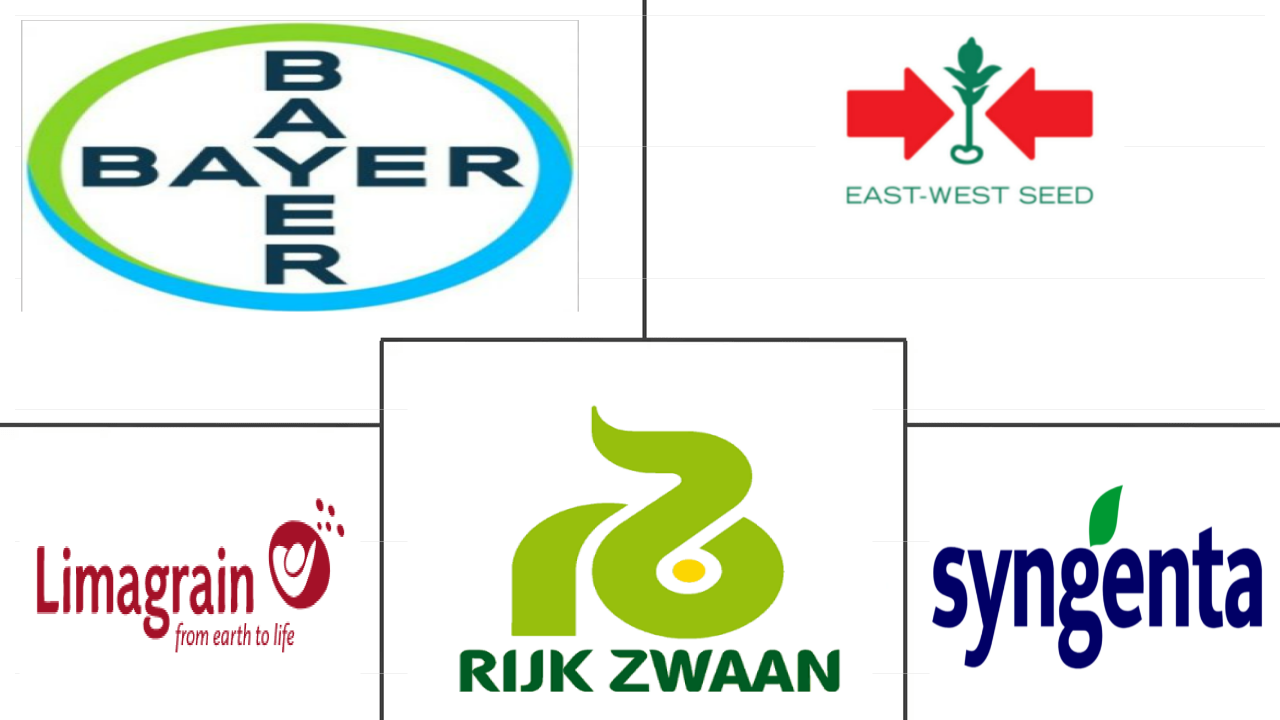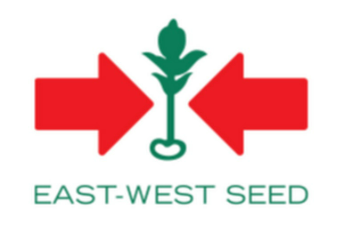Market Size of southeast asia vegetable seed Industry
|
|
Study Period | 2017 - 2030 |
|
|
Market Size (2024) | USD 532 Million |
|
|
Market Size (2030) | USD 708.3 Million |
|
|
Largest Share by Breeding Technology | Hybrids |
|
|
CAGR (2024 - 2030) | 4.89 % |
|
|
Largest Share by Country | Indonesia |
Major Players |
||

|
||
|
*Disclaimer: Major Players sorted in no particular order |
Southeast Asia Vegetable Seed Market Analysis
The Southeast Asia Vegetable Seed Market size is estimated at 532 million USD in 2024, and is expected to reach 708.3 million USD by 2030, growing at a CAGR of 4.89% during the forecast period (2024-2030).
532 Million
Market Size in 2024 (USD)
708.3 Million
Market Size in 2030 (USD)
5.21 %
CAGR (2017-2023)
4.89 %
CAGR (2024-2030)
Largest Market by Crop Family
26.49 %
value share, Solanaceae, 2023
The Solanaceae segment has the largest share due to the increasing area under the cultivation of tomato, chili, and eggplant in the region with a high seed replacement rate.
Largest Market by Country
24.92 %
value share, Indonesia, 2023
Indonesia has the largest share due to the comparatively higher area under vegetable crops in the region, followed by the high usage of hybrids and a high seed replacement rate.
Fastest-growing Market by Crop Family
5.58 %
Projected CAGR, Brassicas, 2024-2030
The rapid growth of the segment is due to an increase in the consumption of salad, the short duration of the crops, high export demand, and suitability to protected cultivation.
Fastest-growing Market by Country
6.91 %
Projected CAGR, Vietnam, 2024-2030
It is the fastest-growing segment due to an increase in the area under cultivation associated with the surge in vegetable demand and the higher adoption of hybrids.
Leading Market Player
5.03 %
market share, East-West Seed, 2022

The company has invested heavily in product innovations and the expansion of its manufacturing units. Recently, the company opened its new seed plant in the Myanmar region.
The demand for high-yielding and disease-resistant varieties is anticipated to increase during the forecast period
- Hybrid and open-pollinated varieties and hybrid derivatives are two major technologies in the region. Hybrid seeds dominated the vegetable seed market by holding a share of 75.2% in 2022 in terms of value.
- Hybrids have a higher share due to higher productivity, wider adaptability, and a high degree of resistance to biotic and abiotic stresses. For instance, in Solanaceae crops, hybrids give 50% more yield than conventional varieties. Hybrids' wider adaptability is mainly due to their high buffering capacity to environmental fluctuations.
- In 2022, Indonesia and Myanmar together accounted for about 46.0% of the total open-pollinated varieties market in the region by value. Open-pollinated varieties require fewer inputs, such as fertilizer and pesticides, and are less expensive and more affordable for low-income farmers, thus boosting the market in the region.
- Similarly, in Southeast Asia, the open-pollinated varieties and hybrid derivatives held a market share of 24.8% by value in 2022. The low share can be mainly due to the preference for high-yielding and disease-resistant hybrids.
- All crops are non-transgenic hybrids, as no countries in the region have approved commercial cultivation of transgenic hybrid vegetable seeds. The hybrid seeds segment is anticipated to be the fastest-growing segment in the region, registering a CAGR of 5.0% during the forecast period, owing to the advantages, such as high yield, disease resistance, and early maturity.
- Therefore, with increasing food demand and the implementation of commercial hybrid varieties, hybrid breeding technology is expected to dominate the market during the forecast period.
Indonesia dominated the Southeast Asian vegetable seed market in 2022
- In Southeast Asia, the vegetable seed market was valued at USD 483.5 million in 2022. Indonesia, Vietnam, and Myanmar are the major contributors to the vegetable seed market in the region. In 2022, these countries together accounted for 49.7% of the regional market. These countries have the highest acreage in terms of vegetable cultivation, accounting for 4.7 million hectares, i.e., 53.7% of the total vegetable acreage in the region in 2022.
- Indonesia dominated the vegetable seed market, accounting for 33.4% of the market in 2022, the highest share in the region, primarily due to its large adoption of commercial seeds and increased vegetable cultivation. The country held the maximum vegetable acreage in the region, recorded at 2.0 million hectares in 2022, i.e., 23.4% of the vegetable acreage in the region.
- Vietnam and Myanmar are the other major contributors to the regional vegetable seed market. In 2022, the vegetable seed market in these countries was valued at USD 64.7 million and USD 55.5 million, respectively. The increased acreage, adoption of protected cultivation methods, and awareness about the benefits of vegetable consumption led to the growth of the seed market in these countries.
- The Philippine and Thai vegetable seed markets were valued at USD 53.8 million and USD 45 million in 2022, respectively. The local governments in these countries initiated pilot projects to encourage the local farmers to cultivate vegetables by providing financial assistance.
- Therefore, factors such as government measures, increasing production and population, growing awareness about the health benefits of raw vegetables, and the demand from processing industries are anticipated to boost the region's vegetable seed market during the forecast period.
Southeast Asia Vegetable Seed Industry Segmentation
Hybrids, Open Pollinated Varieties & Hybrid Derivatives are covered as segments by Breeding Technology. Open Field, Protected Cultivation are covered as segments by Cultivation Mechanism. Brassicas, Cucurbits, Roots & Bulbs, Solanaceae, Unclassified Vegetables are covered as segments by Crop Family. Indonesia, Myanmar, Philippines, Thailand, Vietnam are covered as segments by Country.
- Hybrid and open-pollinated varieties and hybrid derivatives are two major technologies in the region. Hybrid seeds dominated the vegetable seed market by holding a share of 75.2% in 2022 in terms of value.
- Hybrids have a higher share due to higher productivity, wider adaptability, and a high degree of resistance to biotic and abiotic stresses. For instance, in Solanaceae crops, hybrids give 50% more yield than conventional varieties. Hybrids' wider adaptability is mainly due to their high buffering capacity to environmental fluctuations.
- In 2022, Indonesia and Myanmar together accounted for about 46.0% of the total open-pollinated varieties market in the region by value. Open-pollinated varieties require fewer inputs, such as fertilizer and pesticides, and are less expensive and more affordable for low-income farmers, thus boosting the market in the region.
- Similarly, in Southeast Asia, the open-pollinated varieties and hybrid derivatives held a market share of 24.8% by value in 2022. The low share can be mainly due to the preference for high-yielding and disease-resistant hybrids.
- All crops are non-transgenic hybrids, as no countries in the region have approved commercial cultivation of transgenic hybrid vegetable seeds. The hybrid seeds segment is anticipated to be the fastest-growing segment in the region, registering a CAGR of 5.0% during the forecast period, owing to the advantages, such as high yield, disease resistance, and early maturity.
- Therefore, with increasing food demand and the implementation of commercial hybrid varieties, hybrid breeding technology is expected to dominate the market during the forecast period.
| Breeding Technology | |
| Hybrids | |
| Open Pollinated Varieties & Hybrid Derivatives |
| Cultivation Mechanism | |
| Open Field | |
| Protected Cultivation |
| Crop Family | ||||||||
| ||||||||
| ||||||||
| ||||||||
| ||||||||
|
| Country | |
| Indonesia | |
| Myanmar | |
| Philippines | |
| Thailand | |
| Vietnam | |
| Rest of SouthEast Asia |
Southeast Asia Vegetable Seed Market Size Summary
The Southeast Asia vegetable seed market is poised for significant growth, driven by the increasing demand for food and the adoption of commercial hybrid varieties. The market is characterized by a strong preference for hybrid seeds, which dominate due to their higher productivity, adaptability, and resistance to environmental stresses. Hybrid seeds, particularly in Solanaceae crops, offer substantial yield advantages over conventional varieties. While open-pollinated varieties remain popular in countries like Indonesia and Myanmar due to their lower input requirements and cost-effectiveness, the overall trend favors hybrids. The region's vegetable seed market is further bolstered by favorable climatic conditions, with Indonesia, Vietnam, and Myanmar leading in vegetable cultivation acreage. Government initiatives and growing awareness of the health benefits of vegetables are also contributing to market expansion.
The market landscape is fragmented, with major players like Bayer AG, East-West Seed, and Syngenta Group playing pivotal roles. These companies are actively introducing new seed varieties with enhanced traits such as disease resistance and improved quality attributes, which are expected to drive market growth. The region's vegetable cultivation is diverse, with roots, bulbs, and chili being significant segments. Indonesia stands out as the largest contributor to the market, supported by advanced cultivation techniques and high domestic and international demand. The introduction of innovative seed varieties and strategic acquisitions, such as Enza Zaden's expansion into carrot breeding, highlight the dynamic nature of the market. As the region continues to embrace hybrid breeding technology, the vegetable seed market is set to experience robust growth in the coming years.
Southeast Asia Vegetable Seed Market Size - Table of Contents
-
1. MARKET SEGMENTATION (includes market size in Value in USD, Forecasts up to 2030 and analysis of growth prospects)
-
1.1 Breeding Technology
-
1.1.1 Hybrids
-
1.1.2 Open Pollinated Varieties & Hybrid Derivatives
-
-
1.2 Cultivation Mechanism
-
1.2.1 Open Field
-
1.2.2 Protected Cultivation
-
-
1.3 Crop Family
-
1.3.1 Brassicas
-
1.3.1.1 Cabbage
-
1.3.1.2 Carrot
-
1.3.1.3 Cauliflower & Broccoli
-
1.3.1.4 Other Brassicas
-
-
1.3.2 Cucurbits
-
1.3.2.1 Cucumber & Gherkin
-
1.3.2.2 Pumpkin & Squash
-
1.3.2.3 Other Cucurbits
-
-
1.3.3 Roots & Bulbs
-
1.3.3.1 Garlic
-
1.3.3.2 Onion
-
1.3.3.3 Potato
-
1.3.3.4 Other Roots & Bulbs
-
-
1.3.4 Solanaceae
-
1.3.4.1 Chilli
-
1.3.4.2 Eggplant
-
1.3.4.3 Tomato
-
1.3.4.4 Other Solanaceae
-
-
1.3.5 Unclassified Vegetables
-
1.3.5.1 Asparagus
-
1.3.5.2 Lettuce
-
1.3.5.3 Okra
-
1.3.5.4 Peas
-
1.3.5.5 Spinach
-
1.3.5.6 Other Unclassified Vegetables
-
-
-
1.4 Country
-
1.4.1 Indonesia
-
1.4.2 Myanmar
-
1.4.3 Philippines
-
1.4.4 Thailand
-
1.4.5 Vietnam
-
1.4.6 Rest of SouthEast Asia
-
-
Southeast Asia Vegetable Seed Market Size FAQs
How big is the Southeast Asia Vegetable Seed Market?
The Southeast Asia Vegetable Seed Market size is expected to reach USD 531.95 million in 2024 and grow at a CAGR of 4.89% to reach USD 708.31 million by 2030.
What is the current Southeast Asia Vegetable Seed Market size?
In 2024, the Southeast Asia Vegetable Seed Market size is expected to reach USD 531.95 million.

